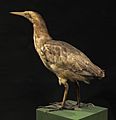Australasian bittern facts for kids
Quick facts for kids Australasian bittern |
|
|---|---|
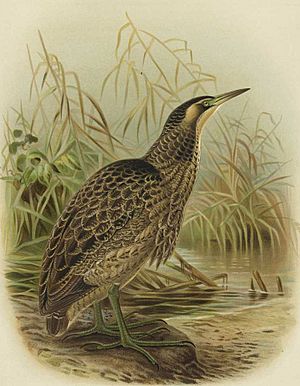 |
|
| By J. G. Keulemans in Buller's A History of the Birds of New Zealand | |
| Conservation status | |
| Scientific classification | |
| Genus: |
Botaurus
|
| Species: |
poiciloptilus
|
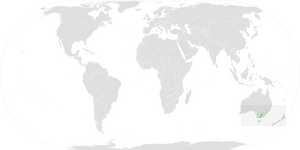 |
|
| Global range Year-Round Range Summer Range Winter Range | |
The Australasian bittern (Botaurus poiciloptilus) is a large bird from the heron family. It's also known as the brown bittern or matuku hūrepo. This bird is quite shy and hard to spot. You're more likely to hear its special booming call than see it! Sadly, Australasian bitterns are in danger of disappearing in both Australia and New Zealand.
Contents
About the Australasian Bittern
The Australasian bittern was first described by a German scientist named Johann Georg Wagler in 1827. It belongs to a group of four similar-looking birds in the Botaurus genus.
What Does It Look Like?
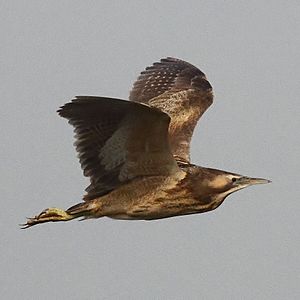
These birds are usually between 65 to 75 centimeters (about 25 to 30 inches) long. Male and female birds look similar, but males are noticeably bigger.
The bittern has a deep brown back with lighter, buff-colored patches on its wings. Its face and eyebrows are buff, with a dark brown stripe running from its beak to the feathers on the sides of its neck. Its belly is buff with brown stripes.
The skin on its face, legs, and feet is a dull green. It has a dark brown beak with a green-yellow base on the lower part. Its eyes are yellow.
How Does It Live?
The Australasian bittern eats animals that live in water. Its diet includes frogs, eels, and freshwater crabs and other crustaceans.
It builds its nest alone on the ground. These nests are hidden in thick wetland plants, often on flattened reeds. Scientists mostly count these birds by listening for the loud calls of the males during breeding season. The best time to hear them is about an hour before sunrise in September, especially on a clear, moonlit night.
Where Does It Live?
This bird can be found in parts of south-western and south-eastern Australia, Tasmania, New Zealand, New Caledonia, and Ouvea. Sadly, the number of Australasian bitterns in Australia and New Zealand has dropped a lot since the 1900s.
It's a very shy bird that is active mostly at night. It lives in wetlands where there is lots of thick plant cover.
Why Is It Endangered?
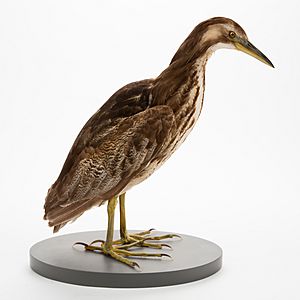
The main reason these birds are disappearing is because their wetland homes are being drained or damaged. In Australia, they are especially sensitive to the loss of places where they can find water during dry times.
The Australasian bittern is listed as an endangered species in Australia. This means it needs special protection to survive. Many groups are working to protect the wetlands where these birds live.
Special Bird Areas
BirdLife International has found several important places in Australia that are crucial for protecting the Australasian bittern. These areas are called Important Bird Areas. They include:
- In New South Wales: Fivebough and Tuckerbil Swamps, Griffith Wetlands, Gwydir Wetlands, Hunter Estuary, and Macquarie Marshes.
- In Tasmania: Egg Islands.
- In Victoria: Barmah-Millewa, Bellarine Wetlands, and Edithvale-Seaford Wetlands.
- In South Australia: Coorong and Lakes Alexandrina and Albert.
- In Western Australia: Benger Swamp and Muir-Unicup Wetlands.
Gallery
-
In the grass, Leeton, New South Wales, Australia
-
Mounted bittern in the collection of the Whanganui Regional Museum
- Radio New Zealand Our Changing World programme "Booming Bitterns", 3 February 2016
- Australasian bitterns discussed on Radio NZ Critter of the Week, 4 Dec 2015
See also
 In Spanish: Avetoro australiano para niños
In Spanish: Avetoro australiano para niños





